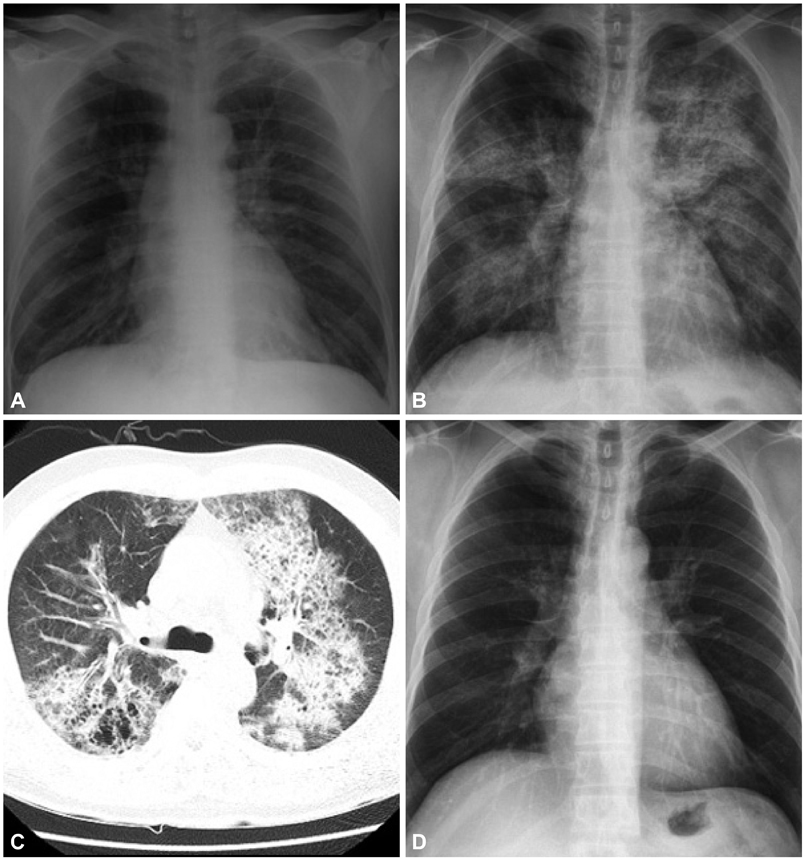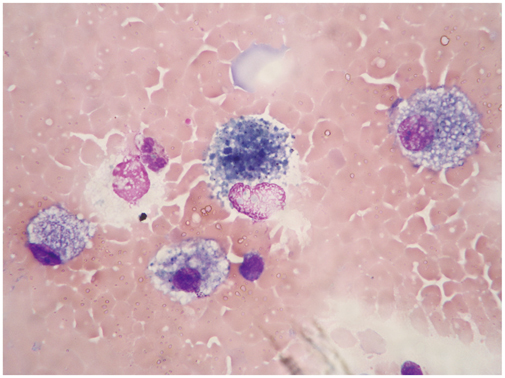Korean Circ J.
2013 Oct;43(10):699-701. 10.4070/kcj.2013.43.10.699.
Very Early Onset of Amiodarone-Induced Pulmonary Toxicity
- Affiliations
-
- 1Department of Internal Medicine, Kangwon National University Hospital, Chuncheon, Korea. rdr0203@gmail.com
- 2Department of Laboratory Medicine, Kangwon National University Hospital, Chuncheon, Korea.
- KMID: 1826562
- DOI: http://doi.org/10.4070/kcj.2013.43.10.699
Abstract
- Amiodarone is a widely used antiarrhythmic agent. Among its various adverse effects, amiodarone-induced pulmonary toxicity (APT) is the most life threatening complication, which has been described mostly in patients who have been in treatment with high accumulative doses for a long duration of time. However, amiodarone therapy in short-term duration induced APT was rarely reported. We describe a case of a 54-year-old man who is presented with symptoms of APT after a few days of therapy for post-myocardial infarction ventricular tachycardia. For early diagnosis and successful treatment, awareness and high suspicion of this rare type of early onset APT is crucial in patients with amiodarone therapy.
MeSH Terms
Figure
Reference
-
1. Dusman RE, Stanton MS, Miles WM, et al. Clinical features of amiodarone-induced pulmonary toxicity. Circulation. 1990; 82:51–59.2. Martin WJ 2nd, Rosenow EC 3rd. Amiodarone pulmonary toxicity. Recognition and pathogenesis (Part I). Chest. 1988; 93:1067–1075.3. Martin WJ 2nd, Rosenow EC 3rd. Amiodarone pulmonary toxicity. Recognition and pathogenesis (Part 2). Chest. 1988; 93:1242–1248.4. Ernawati DK, Stafford L, Hughes JD. Amiodarone-induced pulmonary toxicity. Br J Clin Pharmacol. 2008; 66:82–87.5. Jang WJ, Chon HR, Jung JS, et al. Amiodarone-induced pulmonary toxicity within a short period of the initiation of amiodarone therapy: a case report. Korean J Crit Care Med. 2011; 26:117–121.6. Tanawuttiwat T, Harindhanavudhi T, Hanif S, Sahloul MZ. Amiodarone-induced alveolar haemorrhage: a rare complication of a common medication. Heart Lung Circ. 2010; 19:435–437.7. Papiris SA, Triantafillidou C, Kolilekas L, Markoulaki D, Manali ED. Amiodarone: review of pulmonary effects and toxicity. Drug Saf. 2010; 33:539–558.
- Full Text Links
- Actions
-
Cited
- CITED
-
- Close
- Share
- Similar articles
-
- A Case of Amiodarone-Induced Pulmonary Toxicity
- Amiodarone-induced Pulmonary Toxicity within a Short Period of the Initiation of Amiodarone Therapy: A Case Report
- A Case of Amiodarone-Induced Pulmonary Toxicity After a Long Course of a Low Dose Therapy
- Amiodarone-Induced Pulmonary Toxicity: Percutaneous Needle Aspiration Biopsy and Ultrastructural Findings
- Insidious Onset of Amiodarone Pulmonary Toxicity Presented with Hemoptysis



